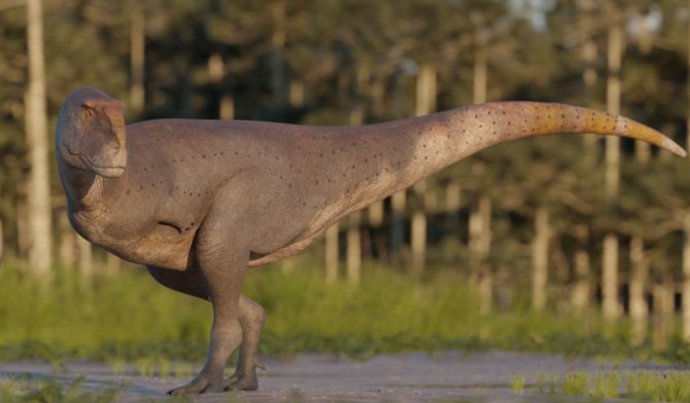3D reconstruction of Koleken inakayali. – GABRIEL DÍAZ YANTÉN.
May 24. () –
A new carnivorous dinosaur that lived in what is now the Argentine province of Chubut about 69 million years ago It has been described and named as Koleken inakayali.
Presented at the Cladistics magazinethe new species belongs to the most important family of carnivorous dinosaurs from Gondwana, the supercontinent of the southern hemisphere that included what are now South America, Africa, India and Madagascar, Australia and Antarctica.
“It is an abelisaurid, a family popularized by the most famous dinosaur on our continent, the horned carnivore Carnotaurus“explains Diego Pol, researcher at CONICET (the public research entity in Argentina) at the Argentine Museum of Natural Sciences “Bernardino Rivadavia” and leader of the research work.
The new species of abelisaurid is distinguished from other carnivorous dinosaurs by a unique set of features found primarily in the skull. The new species shows several differences with Carnotaurus, including a smaller size and the absence of horns on the skull.
“The name Koleken comes from the language of the Tehuelches and means that it comes from clays and water, referring to the fact that the sediments in which the fossil remains were found were clays deposited in an estuary 69 million years ago. The name inakayali pays tribute to the Tehuelche chief Inakayal“, says Pol, and adds: “The new dinosaur is represented by a partial skeleton “which includes several skull bones, a nearly complete set of back bones, a complete hip, several tail bones, and nearly complete legs.”
The discovery was led by paleontologists and staff of the Egidio Feruglio Paleontological Museum in rocks belonging to the La Colonia geological formation, located in the north of the Chubut Province. This region is extremely rich in fossils of all kinds, and Koleken becomes the second abelisaurid that lived in this area near the end of the age of the dinosaurs.
“We found a concretion that contained the preserved rear half of the dinosaur skeleton. Surely the body of this animal was transported by a river to an estuary, where it was buried shortly after its death. In addition, we were able to find remains of the skull in the of the concretion that had been eroded, which explains why the bones of the skull are disarticulated, while the rear part of the skeleton, which was inside the concretion, It is perfectly articulated and in a living position.“comments the researcher.
According to Pol, the new discovery indicates that carnivorous dinosaurs of the abelisaurid family were more diverse than previously believed and that, probably, more than one species of carnivore shared the same environment and ecosystem. “It is possible that Koleken coexisted with its close relative Carnotaurus, in the same way that lions and leopards coexist today in the African savanna or pumas and jaguars in the Misiones jungle. This is interesting because Koleken and Carnotaurus lived very close to the time of the final extinction of the dinosaurs, which is telling us that at least in the carnivores There was a great diversity of species until the moment of extinction“says the researcher.
With the new information provided by Koleken, the team of specialists carried out an analysis on abelisaurids and their close relatives of how quickly different parts of the skeleton evolved. Paleontologist Fernando Novas, CONICET researcher at MACNBR and co-author of the work, comments: “We analyzed the evolutionary relationships of abelisaurids and their closest relatives, the noasaurids, and found periods of time in which these groups changed rapidly, and others periods in which its evolution remained almost at a standstill”.
“This is interesting because it will lead us in the future to explore what may have influenced those marked increases in the evolution of these carnivores“Adds Pol it’s a statement.
The discovery of this new species expands knowledge about dinosaurs from the late Cretaceous. In this regard, another author of the work, paleontologist Mattia Antonio Baiano, from the Ernesto Bachmann Municipal Museum, explains “Koleken reinforces the idea that several species of abelisaurids coexisted in the same habitats during that period. In addition, it demonstrates that abelisaurids were very diverse compared to other groups of dinosaurs. We thought these were the dominant carnivores when the great extinction occurred that wiped out the dinosaurs from our planet.”
















Add Comment